Your feet and your Bikram Yoga Practice.
Have you ever looked down at your feet at the start of a hot yoga class when the teacher says ‘feet together nicely, heels and toes touching’ and wonder how on earth to make that work when your bunions protrude outwards and your big toes are pointing away from each other?
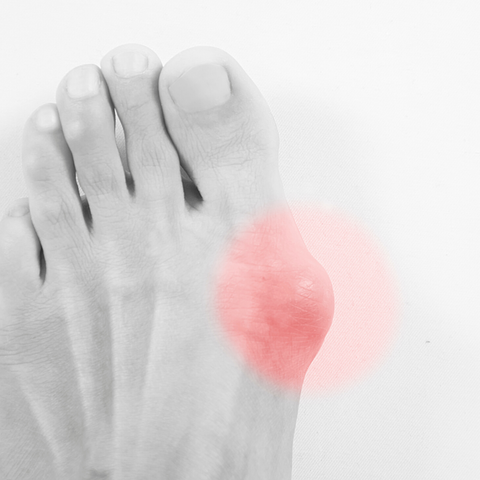
Figure (1). Bunions make it difficult to bring your feet together with your heels and toes touching. They also make it hard to wear a lovely pair of narrow pointy Jimmy Choo's but that's a different blog post.
As my feet are quite anatomically diverse (yep, huge bunions) I’ve struggled with this instruction. Should I force my feet together? Or stand with my heels touching and my bunions touching which gives me a kind of awkward duck stance? Is it more important that my feet are together or that my feet are straight? Does it even matter? We come back to this instruction many times in the Bikram sequence, even in the floor series, and the question niggled away at me until I decided I would investigate it further.
How do bunions occur?
Just like the yoga sequence, our foot has 26 & 2. Bones that is! Twenty six bones and two small sesamoid bones (pea sized bones that sit within a tendon) that run right underneath the first metatarsophalangeal joint (MTP). This where the first long bone of your foot (metatarsal) meets the first bone of the big toe (phalanx). The MTP is the joint that protrudes when a bunion occurs (6. in the below image).
Bunions develop when the adductor hallucis muscle, the muscle that runs left to right underneath your toes (3. in the diagram below)) contracts and tightens. This tightening has the effect of dragging the phalanx bones (2. below) of the big toe towards the other toes and away from the straight position. The displaced MTP joint can get bigger and more painful over time (6). This isn't hideous or ugly. It's just your feet. Some anatomical issues plus or minus some hereditary predispositions. Be kind to them.

Figure (2). 1. First Metatarsophalangeal joint (MTP) 2. First phalanx bone of the big toe. 3. Adductor Hallucis muscle. 4. Abductor Hallucis muscle 5. Midline of the foot 6. Foot with displacement of the MTP or bunion.
Bunions tend to go hand-in-hand with over-pronation. Over-pronation happens when the muscle that runs along the arch under your foot (Abductor Hallucis) becomes overstretched and weak. When strong this muscle helps to pull your big toe back into a straight line however when weak it flattens down the arch as you bear weight on your foot and your foot rolls inwards as a result. "So what?" you might ask. Well, the flow on effect from this for the rest of your body can be big.
When your feet pronate inwards, your tibia (shinbone) also rotates inward. This turns your knees towards each other slightly, which can lead to poor alignment and poor knee tracking, knee pain and hyperextension of the knee joint. Continuing up your leg your thigh bone and hip also rotate inwards and your pelvis tilts forward giving you a 'sway back' or lordosis of the lumbar spine. All because of those pesky weak arches.
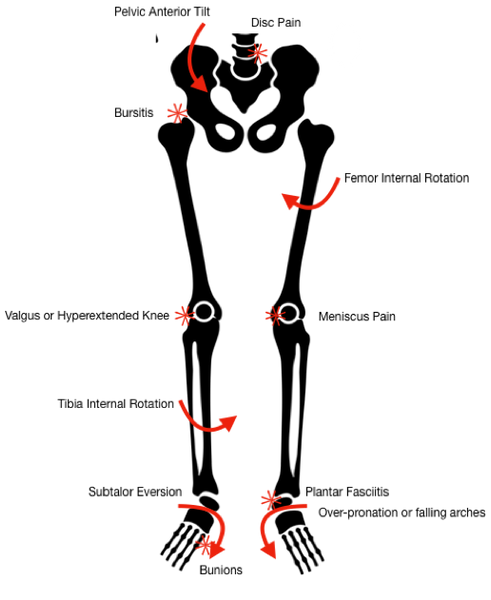
So, feet together or not?
Ah, no. When you have bunions, having your feet together will be unlikely to be a good starting position for you in class for any of the standing or balancing postures. If the midlines of your feet are not parallel then your knees will turn in toward each other. Your knees should face forward for best alignment.
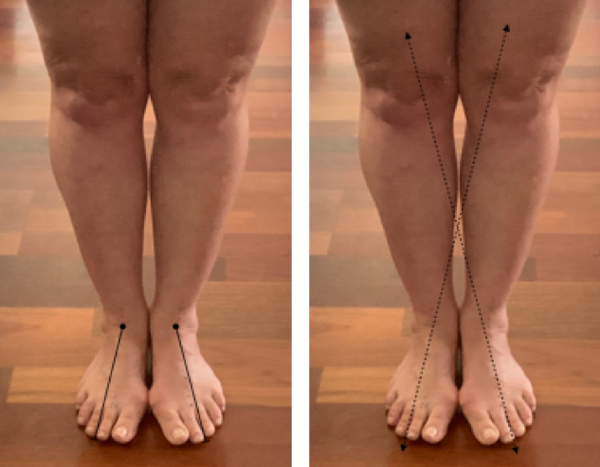
The image above shows very clearly the inward turn of the knees that leads to hyperextension of the knee joint and an over-reliance on the inside of the foot and big toe mound for balance when having your heels and toes together if you also have bunions.
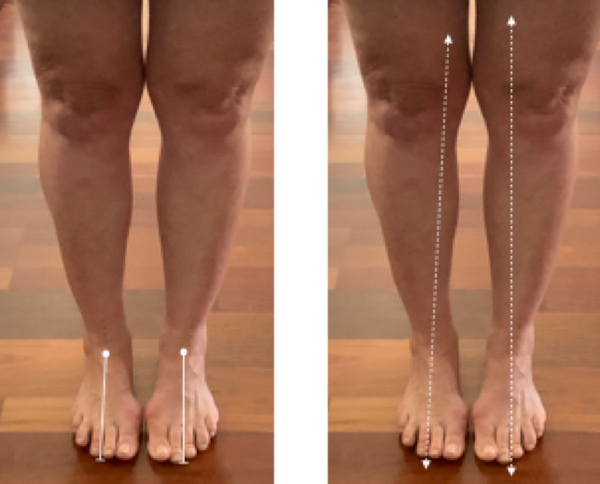
Feet together nicely with bunions.
The first step is to work on correcting the pronation and find your ‘neutral foot’ position. One way to do this is perform ‘short foot’, an exercise (great video here) that works by contracting the underneath of your foot to strengthen and lift your arch. While keeping your toes on the floor, ‘scrunch up’ your arch like you are picking a tissue up with the bottom of your foot. This contracts the abductor hallucis and pulls your big toe back towards centre a little.
Now keeping the arch in its upward position, lift all five toes of each foot off the floor. Maintain the arch height and feel the pressure beneath the big toe mound (probably quite easy to feel). Now equally find the same pressure underneath the small toe mound. Slightly harder isn’t it? Try to ground all four points of your foot in this order. One: under the outside edge of your heel, two: under the little toe mound, Three under the inside edge of the heel and lastly Four: under the big toe mound. Try to share the weight equally across all four points.
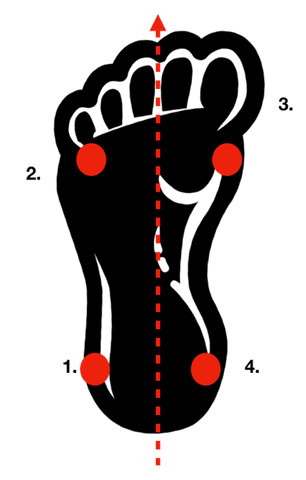
Foot Midline
Observe where your foot midline is. Typically this line runs from the centre of your heel (under your ankle) straight down your foot towards your toes. While keeping these two lines parallel to each other bring your feet together as closely as your anatomy will allow without losing the alignment or the arch activation or the weight distribution. It may look a little like you have your bunions touching and your heels separated. This is your feet together nicely position. It probably won’t look like anyone else, and that’s okay because you are a unique snowflake and have your very own special anatomical make-up!
But, don't just open your heels...
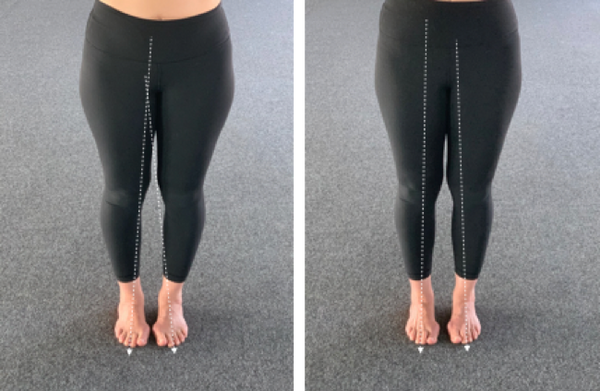
While these two pictures in Figure 7 look similar, closer inspection shows that above left the knees still track toward each other when the foot midline is extended. Whereas on the right, where the arches are active and neutral foot is engaged the knees face forward more. You need to really maintain the contracted arch and work on keeping the foot in neutral. This is really hard. It will feel like you are back at the very beginning of your practice again.
That's because you are. That’s yoga.
More information: if you want to read more about this subject, much of which informed my understanding of this condition in the context of yoga: A great article on preventing and relieving bunion pain by Doug Keller and another on yoga for bunions by Amber Burke. Doug Keller also has a terrific video and also a great video on how to prevent bunions from getting worse with Yoga for bunions.
Namaste!
Disclaimer: I'm not a podiatrist or any other kind of foot specialist. If you have painful feet or need medical advice regarding your bunions then get in touch with the appropriate health professional. I'm a Bikram Method Instructor with a personal interest in anatomy and neuroscience and I researched this topic to improve my own balance and practice.

3 comments
Feb 12, 2020 • Posted by Posy
Great article Jackie!!! Thanks for sharing!
Feb 11, 2020 • Posted by Kristen
Great article Jacki!!
I love educating about bunions and bunion prevention within our yoga practice. You correlated it perfectly to our alignment with great tips to adjust for our bodies!
XO
Feb 11, 2020 • Posted by Janet
Great info!
Leave a comment: